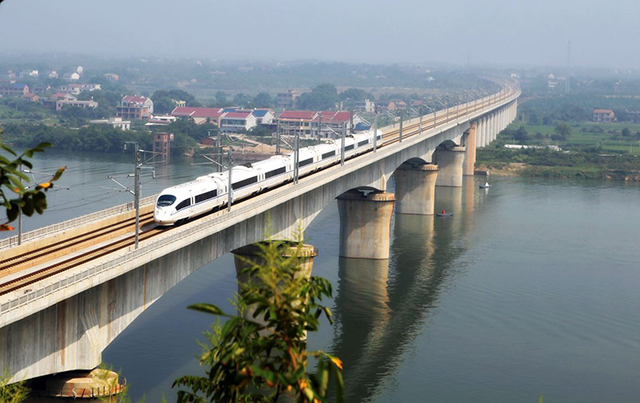China’s railway has a long history. From the beginning of the construction of China’s first railway on June 9, 1881, to the current high-speed railway network extending in all directions across the country. China is at the forefront of the world in transport modernization. Here is the history of the development of Chinese railways.

1. The first diesel locomotive in China
China’s first internal combustion engine was born in Changxindian Locomotive and Rolling Stock Repair Factory on September 9, 1958. Compared with steam locomotives, diesel locomotives have the characteristics of durability, economy, and high efficiency. The diesel locomotive made in China uses electric transmission. The locomotive has a dead weight of 60 tons, a towing capacity of 600 horsepower, and a maximum speed of 85 kilometers per hour. More than 30,000 parts of the locomotive are all made in China.
2, China’s first desert electrified railway
Bao (tou) Lan (zhou) Railway Yingshui Bridge to Gantang Section
3. China’s first railway expert-Zhan Tianyou
During the four years from 1905 to 1909, Zhan Tianyou presided over the construction of the Beijing-Zhangjiakou Railway, the first railway that was completely surveyed, designed and constructed by the Chinese, and invented the automatic train hook.
4. Manufacture of China’s first electric locomotive
The development of China’s railway electric locomotive began in 1958, when the first pilot-tube type electric locomotive was trial-produced. In 1965, a silicon rectifier was used to replace the pilot tube, and after continuous improvement, it was made into a Shaoshan electric locomotive.
5. The first electrified railway in China
The first electrified railway in China was the Baocheng Railway from Baoji, Shaanxi to Chengdu, Sichuan. The total length of the railway is 676 kilometers. The electrification renovation project started in June 1958 and was completed on July 1, 1975. The entire line was officially opened to traffic.
6. The first new railway in China
The first railway newly built after the founding of the People’s Republic of China was the Chengdu-Chongqing Railway from Chengdu in the west to Chongqing in the east. This railway is 505 kilometers long. Construction started in June 1950 and opened to traffic on July 1, 1952. The construction of the railway was entirely made with domestic equipment, thus ending the history of no railway in China that was constructed without borrowing money from foreign countries and purchasing materials from foreign countries.
7. China’s first double-track electrified railway
China’s first double-track electrified railway is Shijiazhuang City in the east and Taiyuan City in the west. The total length of the railway is 235 kilometers. Construction started in October 1974, and the whole line was officially opened to traffic on September 29, 1982.
8. China’s first Sino-foreign joint venture railway
In March 1993, China’s first Sino-foreign joint venture railway-Shenzhen Ping (Hu) Nan (Tou) Railway was completed and opened to traffic. The Pingnan Railway starts from Pinghu Station of the Guangzhou (Zhou)-Shenzhen (Shenzhen) Railway in the east, and ends at Nantou Town, Shenzhen in the west, connecting the three major ports of Shekou, Chiwan and Mawan, with a total length of 50.2 kilometers.
9. China’s first technologically advanced modern railway
China’s first modernized railway with advanced technology, Daqin Railway, was completed and opened to traffic on December 21, 1992. The Da (Tong) Qin (Huangdao) Railway is 653 kilometers long. Construction started in January 1985. It is China’s first technologically advanced dual-track electrified 10,000-ton heavy-duty unit coal railway and the world’s largest railway. . The railway gathers many advanced technologies from the late 1970s and early 1980s internationally.
10. China’s first quasi-high-speed railway and the first high-speed electrified railway
The first quasi-high-speed railway in China, the Guangzhou-Shenzhen quasi-high-speed railway, was completed and opened to traffic in December 1994. This railway runs from Guangzhou East Station in the northwest to Shenzhen Station in the southeast, and runs through the four cities of Guangzhou, Zengcheng, Dongguan, and Shenzhen, with a total length of 147 kilometers. In December 1993, the Guangzhou-Shenzhen line electrification renovation project. On May 28, 1998, the Guangzhou-Shenzhen high-speed electrified railway was completed, becoming China’s first high-speed electrified railway with a speed of 200 kilometers per hour.
11. The first railway group enterprise in China
China’s first railway group enterprise-Guangzhou Railway (Group) Company was established on February 8, 1993. Guangzhou Railway (Group) Company was rebuilt from the original Guangzhou Railway Bureau. The group company is composed of 17 core-tier companies, close-tier companies, semi-close-tier companies and loose-tier companies.
12. The first underground railway in China
China’s first subway is the first phase of the Beijing subway. The first phase of the Beijing subway project started on July 1, 1965, and officially opened on September 15, 1981. The project starts from Beijing Railway Station in the east, passes through 17 stations including Chongwenmen, Qianmen, Xuanwumen and Nanlishi Road, and ends at Apple Orchard in the west, with a total length of 23.6 kilometers.
13. The highest permafrost tunnel
The Fenghuoshan tunnel at an altitude of 4905 meters on the Qinghai-Tibet line is the highest permafrost tunnel in the world.
14. The highest railway station in the world
Located at Tanggula Station on the Qinghai-Tibet Line at an altitude of 5068 meters.
15. China’s first passenger-cargo express railway
Xiang-Pu Railway, also known as (South) Chang-Fu (Zhou) Railway, is China’s first national first-class fast passenger and freight railroad trunk line, passing through Nanchang, Fuzhou, Jiangxi Province, and Sanming, Fuzhou, and Putian, Fujian Province. The main line is 632.359 kilometers long. The design speed is 200 kilometers per hour, 250 roads are reserved, and the freight speed is 160 kilometers per hour.